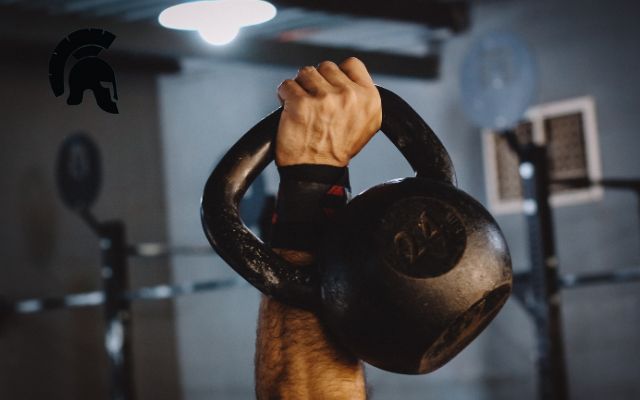Many individuals are concerned about choosing the right kettlebell weight for their fitness journey. Selecting an appropriate weight is crucial for safety, maximizing the training benefits, and preventing potential injuries. This post will walk you through the key factors to consider when selecting your kettlebell weight, offering practical advice based on your individual fitness level and goals.
Too heavy a kettlebell can compromise technique, increasing the risk of injury, particularly in beginners. Conversely, a kettlebell that is too light won’t provide the adequate challenge to stimulate muscle growth and strength development. This comprehensive guide will equip you with the knowledge to make informed choices and embark on a kettlebell fitness journey that’s both effective and safe.
Let’s explore how to select the perfect weight for your kettlebell routine to ensure optimal results and injury avoidance.
How To Know How Much Weight Should You Use For Kettlebell To Start?
Choosing the right kettlebell weight to start depends on your current fitness level and the exercises you plan to do. Here’s a simple guide:
- For beginners: Start light to focus on form.
- Women: 6-8 kg (13-18 lbs)
- Men: 8-12 kg (18-26 lbs)
- For intermediate users: If you’ve been strength training, you can go slightly heavier:
- Women: 10-12 kg (22-26 lbs)
- Men: 12-16 kg (26-35 lbs)
- Check your form: If the kettlebell feels too easy or you can’t maintain control during exercises like swings, deadlifts, or presses, adjust the weight accordingly.
Does The Same Weight Work For All Types of Kettlebell Workouts?
Not exactly. The weight you choose depends on the type of exercise:
Lower Body Exercises (e.g., Deadlifts, Goblet Squats)
These larger muscle groups can handle heavier weights.
-
- Beginners:
- Women: 12-16 kg (26-35 lbs)
- Men: 16-20 kg (35-44 lbs)
- Intermediate:
- Women: 16-20 kg (35-44 lbs)
- Men: 20-24 kg (44-53 lbs)
- Beginners:
Upper Body Exercises (e.g., Presses, Rows)
Since your arms and shoulders are smaller muscles, use lighter weights.
-
- Beginners:
- Women: 6-10 kg (13-22 lbs)
- Men: 10-12 kg (22-26 lbs)
- Intermediate:
- Women: 10-12 kg (22-26 lbs)
- Men: 12-16 kg (26-35 lbs)
- Beginners:
Dynamic Movements (e.g., Swings, Cleans, Snatches)
These need a balance between control and momentum. A moderate weight works best.
-
- Beginners:
- Women: 8-12 kg (18-26 lbs)
- Men: 12-16 kg (26-35 lbs)
- Intermediate:
- Women: 12-16 kg (26-35 lbs)
- Men: 16-20 kg (35-44 lbs)
- Beginners:
How Do I Know When To Increase Or Decrease Weight?
Listen to your body and monitor your performance. Here’s how to decide:
Increase weight when:
- You can easily perform 10-12 reps without breaking a sweat or losing form.
- The weight feels too light and doesn’t challenge you by the end of your set.
- You’re recovering well between sets and sessions.
Decrease weight when:
- Your form starts breaking down before completing your reps.
- You feel strain or discomfort in joints, not muscles.
- You can’t control the kettlebell during explosive or dynamic moves.
Factors Influencing Kettlebell Weight Choice
Fitness Level and Goals
Your current fitness level forms a cornerstone of appropriate kettlebell weight selection. Beginners should prioritize mastering proper technique and foundational strength development. Lighter weights are ideal for this phase, ensuring that form and control are paramount. Intermediate lifters can progressively increase the weight as their technique and strength advance.
Advanced individuals can handle heavier kettlebells for more challenging workouts and specialized exercises, demanding greater strength and power. Your specific goals – whether strength, endurance, or muscle hypertrophy – will also impact your weight choice. For endurance training, lighter weights with higher repetitions are a suitable approach.
Consider your desired outcome when selecting kettlebell weight. Are you aiming for increased muscle size? Lighter to moderate weight with higher reps will be beneficial. Are you focusing on building strength? Moderate to heavier weights with fewer repetitions might be your better option.
Experience with Kettlebells and Other Weights
Your familiarity with weightlifting and kettlebells will influence your choice. Complete novices in any form of weight training should start with lighter weights to develop proper technique. This ensures that you learn the correct movements before attempting more challenging exercises.
If you have some experience with other weights but are new to kettlebells, select a weight that feels challenging but manageable. This ensures that the exercise is effective but not overly demanding, preventing frustration or injury.
Experienced weightlifters may be able to handle heavier weights sooner. However, proper technique should remain the priority. Using the appropriate weight for each exercise helps you stay focused on maintaining form.
Specific Exercises
Different kettlebell exercises demand various weight ranges. Swings, for instance, often require lighter-to-moderate weights for optimal technique and control. Cleans and snatches, requiring more explosive power, typically necessitate a heavier kettlebell, allowing for more weight to be lifted. Goblet squats, however, may use a weight that falls somewhere in between.
Crucially, the same kettlebell weight may not be suitable for all exercises. Understanding this principle helps in choosing appropriate weights for each specific exercise to prevent injury and ensure effective results.
Consider the dynamic nature of kettlebell movements. They involve a complex interplay of movements, and the weight you lift must accommodate the various phases of the exercise. This understanding is critical in choosing the appropriate weight.
Bodyweight and Physique
While there aren’t universally applicable formulas, bodyweight and physique play a role. Generally, taller, heavier individuals might begin with heavier kettlebells. This is because their inherent strength might allow for heavier weights initially. However, relative strength also matters; smaller individuals might demonstrate exceptional strength in relation to their size and warrant a lighter starting weight.
Individual differences significantly impact weight selection. Personal experience with weights, current health status, and physical ability are factors that need to be considered. There’s no one-size-fits-all answer to finding the perfect kettlebell weight.
Don’t be afraid to experiment and find the weight that challenges you appropriately. Bodyweight and physique are elements to consider when selecting kettlebell weight, but they’re not the sole determiners of the ideal weight.
Proper Form and Technique
Proper form is paramount in kettlebell training, and incorrect weight selection can directly contribute to injuries. A weight that’s too heavy will often force you to compromise form, increasing the risk of injury. Maintaining proper form throughout the exercise is essential for a safe and effective workout.
Always prioritize maintaining correct form over lifting heavier weights. A manageable challenge ensures that you maintain proper form, preventing injury. You should feel the exercise, not the strain or pain.
Examples of poor form resulting from improper weight selection include rounded backs, using momentum instead of controlled movements, and strained wrists or shoulders. These issues can lead to pain, long-term injuries, and reduced effectiveness.
Gradual Progression
Progressive overload is fundamental to kettlebell training, allowing your body to gradually adapt and improve. Increasing weights incrementally allows you to consistently challenge yourself as your strength and technique improve. It’s important to understand that there are different ways of making your workout progressively more challenging.
Increasing the weight incrementally ensures that your body has adequate time to adjust and develop. This prevents plateaus and promotes continuous progress. You could gradually increase the number of repetitions or sets, increase the intensity of the exercise (such as lowering the rest time between sets or increasing the tempo), or explore advanced variations that involve increasing the weight or difficulty.
Gradually increase the weight as your body adapts. A progressive approach prevents injuries and ensures that your training is effective and rewarding. Continuous growth through careful progression of weight and training levels leads to an enhanced training experience.
Injury Prevention
Improper weight selection can directly lead to injuries, from strained muscles to joint pain. This is especially true for beginners. Never force movements with heavy weights; this can lead to compromised form and potential injuries. Respect your body’s limits, focusing on technique over lifting heavier weights too soon.
Listening to your body is key to injury prevention. Rest when you need to, and adjust your weight or exercise if you feel pain. A good warm-up and cool-down routine can significantly reduce your risk of injury.
Prioritize injury prevention by choosing the correct kettlebell weight and ensuring proper technique. A balanced approach will enhance the effectiveness of your training, making it safer and more rewarding.
Availability of Kettlebell Weights
Starting with a variety of kettlebell weights, rather than just one, is essential for versatility. This allows you to adapt your workout to different exercises and levels of intensity. Using a range of weights can make a vast difference in the workout.
Not all kettlebell sets have ideal weight increments. Being flexible in your approach and having options is important.
Ensure you have a range of weights to choose from when you are beginning a kettlebell workout regimen. This allows you to tailor your routine to suit your level, goals, and chosen exercises.
Finding a Good Starting Point and Getting Feedback
It is strongly recommended that you consult with a qualified kettlebell instructor. They can assess your fitness level and experience to suggest appropriate starting weights. Starting slowly and receiving feedback on technique is critical.
Seeking guidance from a qualified professional can ensure that you avoid common pitfalls, allowing you to progress safely and effectively. Finding a local certified kettlebell instructor or trainer is an effective way of getting guidance and appropriate kettlebell weight suggestions.
Observing the form of others and getting feedback on your technique can improve your performance. A qualified instructor can provide valuable insight into correct form for each exercise.
Example Weight Recommendations
(Insert a table/chart here with example weight ranges for different exercises and fitness levels. Remember to emphasize ranges, not specific numbers.)
This table will provide sample weight recommendations to get you started, but remember to adapt the weights based on your individual fitness level, experience, and goals.
Adapt these examples for your specific needs. It’s crucial to make adjustments based on your individual experience with kettlebells.
Conclusion
Selecting the right kettlebell weight is a personal journey, influenced by your fitness level, experience, goals, and physique. Consider the key factors discussed, and consult a qualified professional for personalized guidance to optimize your training experience. Remember, progression is key! Adjust the weights as needed and be consistent.
There is no single “right” weight for every individual. Personalized guidance is crucial for safety and effectiveness. Listening to your body is critical, and adjustments should be made as needed.
Always prioritize safety and proper technique over lifting the heaviest weights. A personalized approach is crucial in maximizing the benefits of kettlebell training. Consult a qualified instructor for an ideal starting point.








